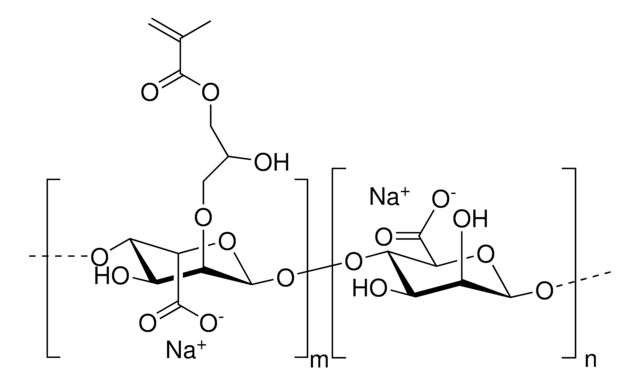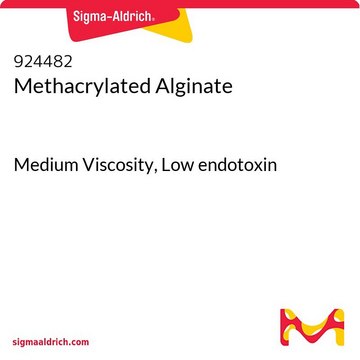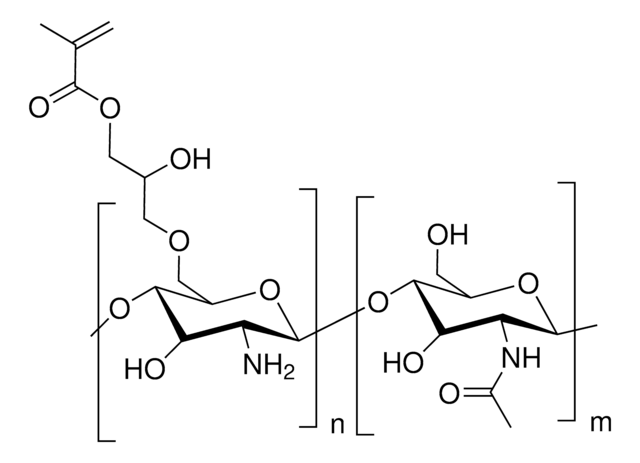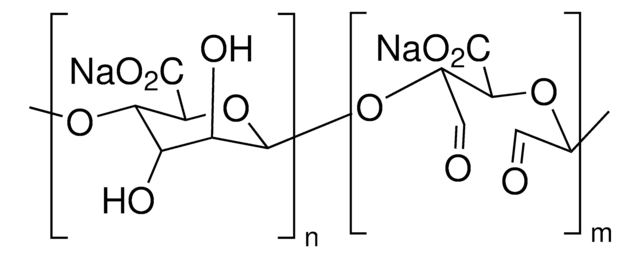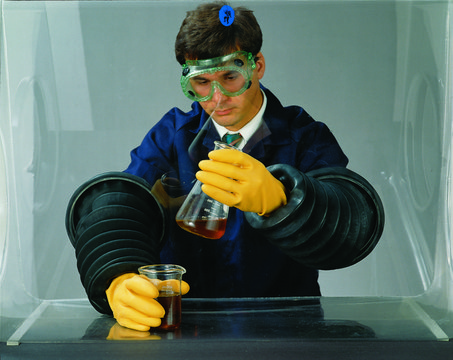911968
Alginate methacrylate
Low viscosity, degree of methacrylation: 10-30%
Synonym(s):
AlMA, Alginate, AlginateMA, Algini acid, Methacrylate-modified alginate, Sodium alginate
Sign Into View Organizational & Contract Pricing
All Photos(2)
About This Item
Linear Formula:
(NaC13H17O10)m (NaC6H7O7)n
UNSPSC Code:
12352201
Recommended Products
form
powder or solid (fluffy)
mol wt
~75 kDa (Alginate)
color
white to off-white
suitability
conforms to structure for NMR
storage temp.
−20°C
Application
Alginate is an anionic polysaccharide that is widely used in pharmaceutical and biomedical applications due to its non-animal origin, low toxicity, biocompatibility, and biodegradability. Alginate hydrogels are commonly used to fabricate tissue engineering scaffolds, bioinks for 3D bioprinting, and nanocarriers for drug & gene delivery. While alginate is commonly crosslinked into a hydrogel via ionic-crosslinking with divalent cations (e.g., Ca2+), these gels feature limited long-term stability due to exchange reactions and migration of divalent cations from the alginate matrix. To prevent matrix degradation, alginate can be functionalized with reactive groups that can be chemically crosslinked, such as methacrylates. Methacrylate-functionalized alginate can be used to prepare hydrogels by thermal or photochemical crosslinking of the terminal methacrylates. Properties of the resulting hydrogel (e.g., stiffness, swelling ratio, rate of degradation) can be tuned by alginate molecular weight, degree of methacrylate functionalization, and crosslink density.
Storage Class Code
11 - Combustible Solids
WGK
WGK 3
Flash Point(F)
Not applicable
Flash Point(C)
Not applicable
Choose from one of the most recent versions:
Certificates of Analysis (COA)
Lot/Batch Number
Don't see the Right Version?
If you require a particular version, you can look up a specific certificate by the Lot or Batch number.
Already Own This Product?
Find documentation for the products that you have recently purchased in the Document Library.
Engineering alginate as bioink for bioprinting
Jia J, et al.
Acta Biomaterialia, 10(10), 4323-4331 (2014)
Alginate: properties and biomedical applications
Lee K Y, et al.
Progress in Polymer Science, 37(1), 106-126 (2012)
K A Smeds et al.
Journal of biomedical materials research, 54(1), 115-121 (2000-11-15)
In situ photopolymerization is an exciting new technique for tissue engineering. Two photocrosslinkable polysaccharides composed of alginate and hyaluronan are described that upon photolysis form soft, flexible, and viscoelastic hydrogels. The degree of methacrylate modification and thus covalent affects mechanical
Siddhesh N Pawar et al.
Biomaterials, 33(11), 3279-3305 (2012-01-28)
Alginates have become an extremely important family of polysaccharides because of their utility in preparing hydrogels at mild pH and temperature conditions, suitable for sensitive biomolecules like proteins and nucleic acids, and even for living cells such as islets of
Oju Jeon et al.
Biomaterials, 30(14), 2724-2734 (2009-02-10)
Photocrosslinked and biodegradable alginate hydrogels were engineered for biomedical applications. Photocrosslinkable alginate macromers were prepared by reacting sodium alginate and 2-aminoethyl methacrylate in the presence of 1-ethyl-3-(3-dimethylaminopropyl)-carbodiimide hydrochloride and N-hydroxysuccinimide. Methacrylated alginates were photocrosslinked using ultraviolet light with 0.05% photoinitiator.
Our team of scientists has experience in all areas of research including Life Science, Material Science, Chemical Synthesis, Chromatography, Analytical and many others.
Contact Technical Service